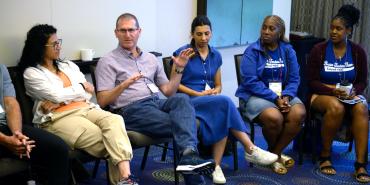No matter who you are when you walk into a classroom, you bring with you one crucial thing: your identity. Or, as Efrat Meyer and Mohammad Kundos (school principals from Israel) illustrated during their TEACH workshop, you bring multiple identities.
Meyer and Kundos represent Hand in Hand—Israel’s only school network providing integrated, bilingual, multicultural Jewish-Arab education. Since the program’s inception 25 years ago, Hand in Hand schools can now be found in six cities teaching Jewish and Arab students about the importance of living together, respecting and learning about each other’s backgrounds and religions, and joining together every day in peace and harmony. Similar to the program in Israel, the TEACH workshop was led by two educators: Meyer who is Jewish, and Kundos who is Arab.
Their workshop, “Individual and Collective Identity,” was based on a series of group exercises meant to explore personal identities as well as create the empathetic skills to recognize similarities, which might otherwise go unnoticed, giving participants some tested tactics in bringing harmony and understanding into the classroom.
Breaking down identity and barriers
For the first exercise, roughly 30 participants joined in a circle to share the aspects of their lives that best speak to who they are. The responses ranged from “mother” and “teacher” to “learner” and “baseball fan.” Once the group had established these identities (if only temporarily), Kundos asked the group to get ready to be a bit uncomfortable as he began a game similar to musical chairs. While playing the tar, a traditional Arab drum, Kundos had everyone roam the room until he stopped playing. Once he stopped, participants had to engage the person in front of them without speaking in a simulation of communicating across language barriers, an issue the Hand in Hand program works to resolve every day.
Identity shift and crisis
In the second exercise, the issues of identity crisis, conflict and intimacy came front and center, starting when participants added two dates to a timeline—one important moment for their personal identity and another for their collective identity. When mapped on a physical timeline, the exercise showed that any one person can have major shifts in their identity across time.
Last, the group was split into four sections in which one member shared a moment when they felt an identity crisis. The group then acted out that personal moment on an imaginary Broadway stage, with the majority of the group acting like Greek muses, expressing the emotional turmoil inherent in the story.
The participants—mostly teachers from across the country—said they found the workshop emotional and enlightening; many noted that it helped them better understand themselves and the perspectives of those around them.
[James Hill]

